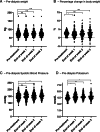Safely reducing haemodialysis frequency during the COVID-19 pandemic
- PMID: 33287730
- PMCID: PMC7720264
- DOI: 10.1186/s12882-020-02172-2
Safely reducing haemodialysis frequency during the COVID-19 pandemic
Abstract
Background: Patients undergoing haemodialysis (HD) are at higher risk of developing worse outcomes if they contract COVID-19. In our renal service we reduced HD frequency from thrice to twice-weekly in selected patients with the primary aim of reducing COVID 19 exposure and transmission between HD patients.
Methods: Dialysis unit nephrologists identified 166 suitable patients (38.4% of our HD population) to temporarily convert to twice-weekly haemodialysis immediately prior to the peak of the COVID-19 pandemic in our area. Changes in pre-dialysis weight, systolic blood pressure (SBP) and biochemistry were recorded weekly throughout the 4-week project. Hyperkalaemic patients (serum potassium > 6.0 mmol/L) were treated with a potassium binder, sodium bicarbonate and received responsive dietary advice.
Results: There were 12 deaths (5 due to COVID-19) in the HD population, 6 of which were in the twice weekly HD group; no deaths were definitively associated with change of dialysis protocol. A further 19 patients were either hospitalised and/or developed COVID-19 and thus transferred back to thrice weekly dialysis as per protocol. 113 (68.1%) were still receiving twice-weekly HD by the end of the 4-week project. Indications for transfer back to thrice weekly were; fluid overload (19), persistent hyperkalaemia (4), patient request (4) and compliance (1). There were statistically significant increases in SBP and pre-dialysis potassium during the project.
Conclusions: Short term conversion of a large but selected HD population to twice-weekly dialysis sessions was possible and safe. This approach could help mitigate COVID-19 transmission amongst dialysis patients in centres with similar organisational pressures.
Keywords: COVID-19; Coronavirus; Haemodialysis; Mortality; SARS-CoV-2; Twice weekly.
Conflict of interest statement
Professor Kalra reports grants and personal fees from Vifor, personal fees from AstraZeneca, outside the submitted work. No other authors have anything else to declare.
Figures



Similar articles
-
Renal replacement treatment initiation with twice-weekly versus thrice-weekly haemodialysis in patients with incident dialysis-dependent kidney disease: rationale and design of the TWOPLUS pilot clinical trial.BMJ Open. 2021 May 24;11(5):e047596. doi: 10.1136/bmjopen-2020-047596. BMJ Open. 2021. PMID: 34031117 Free PMC article. Clinical Trial.
-
[The COVID-19 pandemic and hemodialysis: a multicentric experience].G Ital Nefrol. 2020 Dec 7;37(6):2020-vol6. G Ital Nefrol. 2020. PMID: 33295703 Italian.
-
Use of Renin-Angiotensin System Blockers Increases Serum Potassium in Anuric Hemodialysis Patients.Am J Nephrol. 2018;48(2):79-86. doi: 10.1159/000491552. Epub 2018 Aug 2. Am J Nephrol. 2018. PMID: 30071530
-
A call to optimize haemodialysis vascular access care in healthcare disrupted by COVID-19 pandemic.J Nephrol. 2021 Apr;34(2):365-368. doi: 10.1007/s40620-021-01002-4. Epub 2021 Mar 8. J Nephrol. 2021. PMID: 33683675 Free PMC article. Review.
-
COVID-19 and ESKD, A Rapid Review.R I Med J (2013). 2020 Sep 4;103(8):29-33. R I Med J (2013). 2020. PMID: 32900009 Review.
Cited by
-
Occupational exposure of healthcare workers to COVID-19 and infection prevention control measures in haemodialysis facilities in North West of England.Infect Prev Pract. 2021 Sep;3(3):100150. doi: 10.1016/j.infpip.2021.100150. Epub 2021 Jun 5. Infect Prev Pract. 2021. PMID: 34316586 Free PMC article.
-
Mortality associated with the COVID-19 pandemic in the Swiss dialysis population beyond SARS-CoV-2 infection.Clin Kidney J. 2024 Oct 29;17(12):sfae322. doi: 10.1093/ckj/sfae322. eCollection 2024 Dec. Clin Kidney J. 2024. PMID: 39664996 Free PMC article.
-
Impact of incremental initiation of haemodialysis on mortality: a systematic review and meta-analysis.Nephrol Dial Transplant. 2023 Feb 13;38(2):435-446. doi: 10.1093/ndt/gfac274. Nephrol Dial Transplant. 2023. PMID: 36130107 Free PMC article.
-
The Global Impact of the COVID-19 Pandemic on In-Center Hemodialysis Services: An ISN-Dialysis Outcomes Practice Patterns Study Survey.Kidney Int Rep. 2022 Mar;7(3):397-409. doi: 10.1016/j.ekir.2021.12.011. Epub 2021 Dec 13. Kidney Int Rep. 2022. PMID: 34957349 Free PMC article.
-
Prevalence of Latent Tuberculosis Infection among Patients Undergoing Regular Hemodialysis in Disenfranchised Communities: A Multicenter Study during COVID-19 Pandemic.Medicina (Kaunas). 2023 Mar 26;59(4):654. doi: 10.3390/medicina59040654. Medicina (Kaunas). 2023. PMID: 37109612 Free PMC article.
References
-
- Scarpioni R, Manini A, Valsania T, De Amicis S, Albertazzi V, Melfa L, et al. Covid-19 and its impact on nephropathic patients: the experience at Ospedale “Guglielmo da Saliceto” in Piacenza. G Ital Nefrol. 2020;37:2020. - PubMed
MeSH terms
Substances
LinkOut - more resources
Full Text Sources
Medical
Miscellaneous

